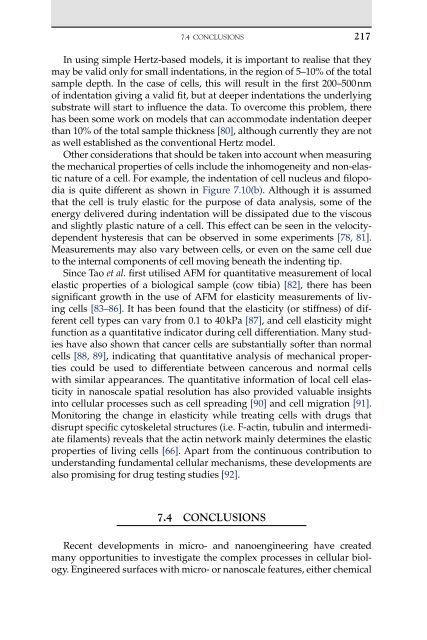W. Richard Bowen and Nidal Hilal 4
W. Richard Bowen and Nidal Hilal 4
W. Richard Bowen and Nidal Hilal 4
- No tags were found...
You also want an ePaper? Increase the reach of your titles
YUMPU automatically turns print PDFs into web optimized ePapers that Google loves.
7.4 CONCLUSIONS 217<br />
In using simple Hertz-based models, it is important to realise that they<br />
may be valid only for small indentations, in the region of 5–10% of the total<br />
sample depth. In the case of cells, this will result in the first 200–500 nm<br />
of indentation giving a valid fit, but at deeper indentations the underlying<br />
substrate will start to influence the data. To overcome this problem, there<br />
has been some work on models that can accommodate indentation deeper<br />
than 10% of the total sample thickness [80], although currently they are not<br />
as well established as the conventional Hertz model.<br />
Other considerations that should be taken into account when measuring<br />
the mechanical properties of cells include the inhomogeneity <strong>and</strong> non-elastic<br />
nature of a cell. For example, the indentation of cell nucleus <strong>and</strong> filopodia<br />
is quite different as shown in Figure 7.10(b). Although it is assumed<br />
that the cell is truly elastic for the purpose of data analysis, some of the<br />
energy delivered during indentation will be dissipated due to the viscous<br />
<strong>and</strong> slightly plastic nature of a cell. This effect can be seen in the velocity-<br />
dependent hysteresis that can be observed in some experiments [78, 81].<br />
Measurements may also vary between cells, or even on the same cell due<br />
to the internal components of cell moving beneath the indenting tip.<br />
Since Tao et al. first utilised AFM for quantitative measurement of local<br />
elastic properties of a biological sample (cow tibia) [82], there has been<br />
significant growth in the use of AFM for elasticity measurements of living<br />
cells [83–86]. It has been found that the elasticity (or stiffness) of different<br />
cell types can vary from 0.1 to 40 kPa [87], <strong>and</strong> cell elasticity might<br />
function as a quantitative indicator during cell differentiation. Many studies<br />
have also shown that cancer cells are substantially softer than normal<br />
cells [88, 89], indicating that quantitative analysis of mechanical properties<br />
could be used to differentiate between cancerous <strong>and</strong> normal cells<br />
with similar appearances. The quantitative information of local cell elasticity<br />
in nanoscale spatial resolution has also provided valuable insights<br />
into cellular processes such as cell spreading [90] <strong>and</strong> cell migration [91].<br />
Monitoring the change in elasticity while treating cells with drugs that<br />
disrupt specific cytoskeletal structures (i.e. F-actin, tubulin <strong>and</strong> intermediate<br />
filaments) reveals that the actin network mainly determines the elastic<br />
properties of living cells [66]. Apart from the continuous contribution to<br />
underst<strong>and</strong>ing fundamental cellular mechanisms, these developments are<br />
also promising for drug testing studies [92].<br />
7.4 ConCluSIonS<br />
Recent developments in micro- <strong>and</strong> nanoengineering have created<br />
many opportunities to investigate the complex processes in cellular biology.<br />
Engineered surfaces with micro- or nanoscale features, either chemical
















